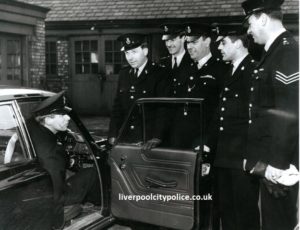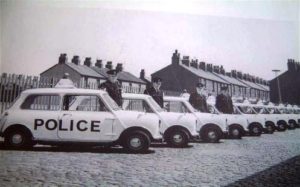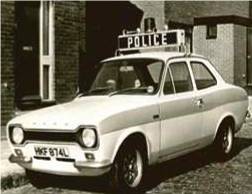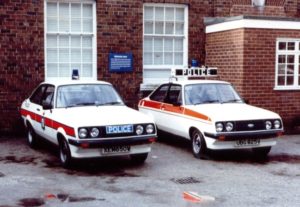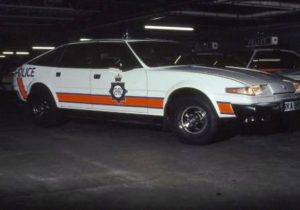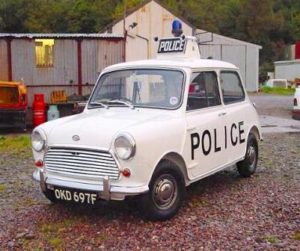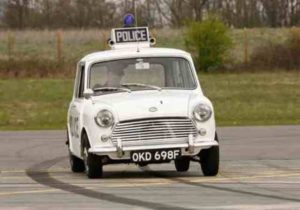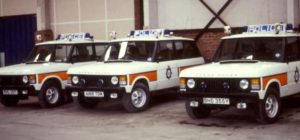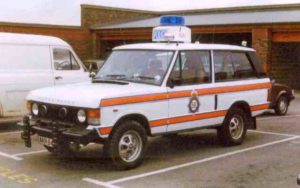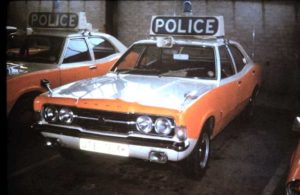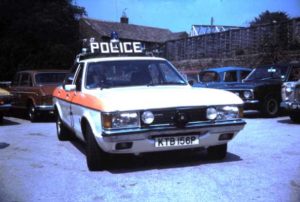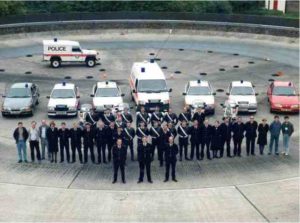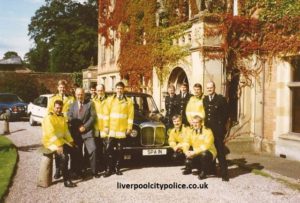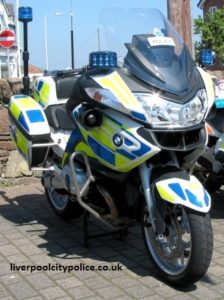TRAFFIC by dave richards, retired
Memories of the Traffic Department
I joined Wallasey Borough Police and was posted to the traffic department in 1966. There was no driving course as there are today, all that was required was that you held a full licence and the Traffic Inspector (God) took you out for a drive in several of the force vehicles. Remember this was a small borough Police Force. The last one being the Wallasey Borough Police Van which had a crash box and required the use of a technique long forgotten, of double de-clutch, the ability to change gear without a crunching grinding noise both up and down the gear box. If you could do that then it was almost certain that you got a posting to Traffic. I had no problem with the crash gear box as I had originally learnt to drive on a small tractor being a country lad at heart.
So my traffic career started. At first I was the incident car or night crime van driver which consisted of the Sergeant and sometimes the night inspector and two Police Constables. The Police Vehicles had radios and made sure that a police officer attended any 999 call within 3 minutes. Beat Officers only had the Police Pillar telephones/public phone as the means of communication until the introduction of the “Lancon “radio and later the Pye Pocket phone. Returning to beat duties for the daytime shifts which consisted of 6am to 2pm, 2pm to 10pm shifts working seven days then two days off with two quick changes and one weekend in four off.
Parades took place in your time as they happened 15 minutes before you went out on Patrol and if you were late you were reported, late twice in a week or was that a month then you faced a charge.
In 1967 the amalgamation of the boroughs with Cheshire Constabulary took place, which happened on the 1st April 1967. I must admit that the changeover was relatively smooth as the cars and the new pandas had all been fitted with the new radios prior to the amalgamation and we were encouraged to try it out. Quite a dramatic change from the shared radio frequency used by Wallasey and Birkenhead boroughs Police Forces. I was then sent on my first driving course. A Motor bike course which was held at the driving school at Crewe, in what was the old nunnery in Nantwich Road, the course was residential and you stayed with local B&B ladies, some of who had a reputation, but that’s all I ever found out!
The course lasted 3 weeks and if you passed you eventually got traffic and I did. A class one and then posted to the bikes. My first bike was a BSA Rocket and I spent 3 happy years on the bikes riding that and the first Triumph 650 twin “ saint” motor cycle, and I even remember the registered number around the roads of the Wirral and beyond. The area covered by Wallasey Traffic Department now renamed “B” Division extended out to the Welsh border and as nearly as far as Chester itself “A” division was the Birkenhead side of the Wirral peninsula. Oh Happy days, putting out cones before the advent of the dual carriageway at Woodbank to assist with the traffic flow into North Wales in conjunction with the Welsh constabulary. Manning the traffic lights there and operating them manually to assist the traffic flow both into and out of Wales. Getting a key to the traffic light box required a bit of guile, otherwise you had to wait for a colleague to bring the one from the office. I had been sent on a car driving course in the meantime, gaining a Class 1 Advanced to my delight, making me a dual qualified driver which meant in the very cold icy weather I was able to take out a spare traffic car. Much better than getting freezing cold and wet on my motor bike, but I still enjoyed my motorcycling only giving up late into the 80’s
I well remember having to learn, virtually parrot fashion the Road Craft book especially the 10 commandments in the front of the book. How did it go?
“Concentration is the keystone of all good driving ……. Etc ….. It’s still in there somewhere, I think I still have the book, the new version is not quite the same, but the basic principles remain.
Escorting those big loads to the docks in Birkenhead, and latterly, the long, concrete bridge sections, and metal box sections for the Bidston flyover destined for the M53 which was in the process of being built.. One lasting memory is “ Operation Move” which involved the movement of what was then the three largest single objects by road to the Stanlow Oil refinery. The details of which can be found on the internet The three parts of the new catalytic cracker, Eric McArdle was the chief Superintendent ( Western Divisions) with Clive Dawson his deputy.
It was a great job in the dry but awful in the rain and cold. (No leathers and waterproofs as we know them today.) We bought our own motorcycle boots in those early days with our boot allowance. Latter they became standard issue.
I was then posted onto the cars much to my annoyance, even though I objected as much as I could, as I enjoyed the freedom of the bikes, but cars it was, and into a Ford Cortina GT. What a super car that was, fast for its day it had extremely good road handling and proved very reliable. The cars we had during my traffic experiences were the awful Morris Marina 1.8TC, Variants of the Ford Granada, the Rover SD1 3.5 V8 and finally the Vauxhall Senator 3.O which I suppose was one of the best traffic cars I ever had the privilege to drive, although the Rover SD1 does hold some very special memories. The M53 motorway was opened in 1972 and I was posted to Motorway duties and sent to the M6 on a very steep learning curve from the guys down there for a few days and my admiration for the work the motorway guys do, still remains with me. Twelve officers were posted to the Wirral Motorway section and worked the three shift system with 3 men on a shift and always one double manned car out at all times. The spare man worked a day shift while the other two worked straight shifts. We had a small motorway post (Police station) at Woodchurch interchange (Now a dental technician workshop). Everything was there, telephones, a base radio station, and parking for the two range rovers which carried everything we should ever require from water to a full first aid kit and fire extinguishers, as well as cones and signs and flashing lights, you name it and I think we carried it, over a ton of equipment. The most important place at the post was a small kitchen and cooker as working on the motorway demanded that you were on call all the time and things always happened at scoff time I lost count of the number of ruined meals. The only time you were permitted to leave the strip as it was called was to collect the mail from Bromborough and get fuel from Wallasey, Birkenhead or Bromborough Police stations. Cheshire Constabulary was at the forefront of Motorway policing in those early days having one of the busiest motorways to police and the procedures and practices that took place formed the foundation of the Motorway Police Handbook, adopted and modified by many of the national Police forces at the time.
Driving a fully laden Range Rover demanded a slightly different driving style and I remember going to the Rover proving track at Solihull to be taught just what they were and still are capable of. (Now that was a good couple of days). I spent some happy times and made some long lasting friendships on the motorway which endure to today. I well remember towing a fully laden articulated wagon off the motorway with the Range Rover and our standard issue Tow rope which was of nylon construction and was never the same after that tow! It stretched … just a little.
Pulling cars out of the sand hills in Wallasey and other hard to get to places on the Wirral using the four wheel drive facility took up some of our time, but never to the detriment of policing the motorway. What they were doing in there in the first place always brought a smile to our faces. It was always impressed on us that we had to keep the traffic flowing. Closing the road was a last resort not like in today’s health and safety climate. They really are go anywhere vehicles and we all stretched the imagination of what they were capable of to the limit, but they always came through it. The only down side of carrying so much weight in the rear of the vehicle meant that should we ever have the need to negotiate steep hills we were advised to go up backwards as they had a habit of becoming very light on the front end.
We lost two friends in a horrific accident near to Woodchurch Interchange, Norman Jones was an ex Birkenhead Borough man and jimmy Byers who I had in company with me in the early days and also on his traffic attachment. His brother had been a serving officer with Wallasey Borough back in 1965.
After 3 or was it 4 years I was posted back to normal traffic duties on the Wirral at Bromborough Police Station which had become the traffic HQ for the western area of Cheshire constabulary covering Wallasey Birkenhead, and a small part of Ellesmere Port, and out to the A5117 which was the main arterial road into Wales as far as the Welsh border. The garages for servicing were there and an extensive suite of offices and a canteen. There was even a court which made things quite handy, but eventually that was only used for coroners’ inquests.
1974 was here and big seemed better in those days, and the natural barrier of the River Mersey which separates Liverpool from the Wirral, was as far as the politicians were concerned, no longer a barrier, although back in 1967 when Wallasey and Birkenhead had requested to join the newly formed Liverpool and Bootle Constabulary, the lack of crossing points and the physical barrier of the river was the main objection to the proposal.
So the reorganisation as it was called took place on the 4th April 1974. The formation of the new county of Merseyside which has since been abandoned and things have reverted back to smaller more manageable Districts. I was on nights on the changeover and from my recollections, it was a fiasco. It was planned to take place at midnight just about the busiest time and I well remember switching back over the Cheshire radio frequency as no one at the Merseyside Force control room had any idea of what and where to send cars. Please don’t take this as criticism of the people who had to work the new system but it was all down to the lack of organisation at top level that caused the problem. They never did and still don’t appear to consult the people who have to work the systems they devise. The guys on the ground were never consulted and I must admit there was and still is a certain amount of opposition to “Liverpool”. It all eventually got sorted out. Spekeland Street was the HQ for traffic in the new Merseyside Police Force although the Chief Superintendent Traffic ( Eric Wright) was based at HQ in Hardman Street. It appeared to me on my first visit rather an old ramshackle building just off Smithdown Lane near to the Liverpool royal infirmary and Mount Vernon. With Big Metal doors and the admin offices on the landing and A greengrocery wholesale business using the other half of the building. I only ever went there a couple of times, as Bromborough was still the main traffic station for the Wirral and the need to go to Liverpool happened only on the odd occasion. The New traffic HQ at Smithdown Lane was nearing completion and was in fact opened in 1976. It was purpose built housing the group one and five traffic groups, the driving school, chief superintendent, the traffic administration office, along with some specialised departments and the garages for servicing and getting specialised traffic equipment and believe it or not cleaning agents as we were expected to clean the cars, all issued from Dave Clarkes Office!.
After the fiasco of the first day of the Merseyside Force, applications to work in the force control room at Hardman Street was put out in force orders, and I along with others applied to work in the control room, as it was then, part of T division. I had what was required a extensive knowledge of the Wirral and Motorway Policing and also some knowledge of Liverpool, as I had spent some very happy years in my childhood in Liverpool and attending school there until 18 years of age but as they say that is another story.. I was transferred to the control room. I spent some happy hours in there, meeting some former colleagues and making new lifelong friends. I suppose that it was there that my interest in computers was developed as I was sent to Hendon to attend a course on the development of the now well known criminal names and fingerprint index. During my varied career in traffic I certainly met some characters. Names that I class as synonymous with the traffic department as I knew it, are Eric Wright who was the Ch Supt Traffic at the amalgamation as far as I remember, it would be wrong of me to name only some of the people and characters I met after the Liverpool and Bootle , Southport and Cheshire reorganisation, and it would be wrong to try and name them all but I remember those curries and chips on nights with a certain sergeant who was posted over to the Wirral in 1975, he always seemed to want to come out with me and we did have some good times together and have remained friends ever since. The other Chief Superintendents that I recall are Eric Higham, Gilbert Hughes, David Anderton as well as some of the Superintendents Max Woosey, Neil Coles Vic Swift. And others I cannot remember so please forgive me.
The Traffic groups had a Chief Inspector at its head and then the usual command structure, inspectors and sergeants and of course constables.
Liverpool and Bootle had the Minis and latter the small fast Mexico Escort along with some of the larger cars but the Mini Cooper and the Mexico Escort were well suited to the streets of the city and its suburbs. The outer groups, I remember had bigger cars or so it appeared.
Several traffic groups were formed after the 1974 reorganisation.
Groups1 and 5 were based at Smithdown Lane and covered what was primarily the Liverpool City area and Speke and Halewood.
Group 2 based at Bromborough covered the old boroughs of Birkenhead and Wallasey and the former areas of Cheshire as far as Hooton and Neston on the Wirral and of course the M53 motorway.
Group 3 was based at Maghull and Southport and covered that expanse of land along the coastal strip as well as Bootle and Crosby.
Group 4 was based at Oliver Lyme Road in an industrial building and covered the St Helens Prescot and Knowsley areas as well as the M62 and M57 Motorways.
Traffic Patrol was becoming a very specialised department within the Police Service. with the advance of technology and forensic science making the investigation of what we called Traffic Accidents more specialised. Even the basic speeder required the use of technology. They use very sophisticated computer and GPS tracking, use in-car cameras and video recording equipment, and even number plate recognition is now in car. The driver records are all held on computer these days making use of the HORT/1 a thing of the distant past. People were becoming specialists in Goods vehicle legislation and traffic accident investigation. Gone are the days of using a few cones and a couple of signs around a traffic accident which are now renamed road traffic collisions, filling in a few forms, taking a few statements, drawing a picture.
My days as an operational traffic police officer ended in 1979 when I was attached to the Chief Constables Office.
I am sure others will have more memories and will be able to add more detail to this personal memory and I hope that you will.
Dave Richards (June 2012)


